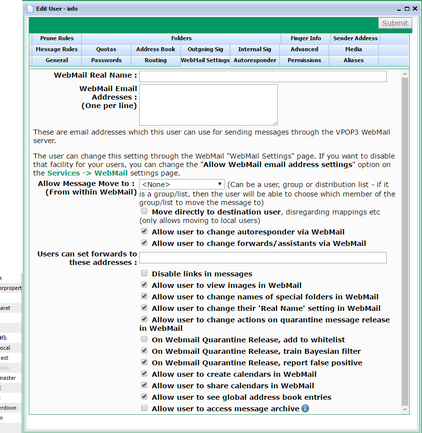
The user's Webmail Settings tab defines settings for VPOP3's Webmail for this user.
WebMail Real Name is the name used as the sender's name when sending messages from VPOP3's Webmail.
WebMail Email Addresses is a list of email addresses which this user can select from when sending messages from VPOP3's Webmail. If the box is blank, then only the sender's main email address (as defined in the Address Book tab) can be used, otherwise any of the email addresses listed here can be selected. The user can edit these addresses themselves in their Webmail settings, unless you disable the Allow WebMail Email Address Settings by users in Services -> WebMail -> WebMail Settings.
The Allow Message Move to option allows the user to move a message to the selected user(s) from within Webmail. If you choose a group or list here, then the user will be able to select which group/list member the message is to be moved to. If you choose a user here, then the message can only be moved to that user.
The Allow user to change autoresponder via WebMail option allows the user to modify their own autoresponder from within Webmail.
The Allow user to change forwards/assistants via WebMail option allows the user to modify their own forwarding & assistant settings.
The Users can set forwards to these addresses option indicates which email addresses the user can set their forwarding & assistant settings to via Webmail. This is either a regular expression or a wildcard address. Only one entry can be specified here, so you could use a specific email address or a wildcard expression like *@mydomain.com or a regular expression line /^(bob|kate|joe)@mydomain\.com$/. If this is blank, then any address can be specified.
The Disable links in messages option means that any links in email messages displayed in Webmail are disabled and will not work. If this option is not checked, then links will work as normal. This option can be useful if users are not very careful about what they do.
The Allow user to view images in WebMail option allows the user to view images in email messages in Webmail. If this option is not checked, then placeholders are displayed instead. This may make some messages harder to read, but will prevent inappropriate images or tracking images being displayed.
The Allow user to change names of special folders in WebMail option allows the user to change which folder will be the 'deleted items' or 'sent items' folders. Usually this is OK, but it can be useful to disable this if you have a user who sets them inappropriately or to make support easier sometimes.
The Allow user to change their 'Real Name' setting in WebMail option allows the user to change their real name on sent messages from Webmail. You may want to restrict this to prevent users pretending to be someone they are not.
The Allow user to change actions on quarantine message release in WebMail allows the user to change whether sender addresses are added to the spamfilter whitelist etc when releasing messages from the quarantine via Webmail.
The On Webmail Quarantine Release, add to whitelist/train Bayesian filter/report false positive options set the default options for when releasing messages from the quarantine. If the above Allow user to change actions on quarantine message release in WebMail option is checked, then the user can change these options if they wish for each message they release.
The Allow user to create calendars in Webmail option (only in VPOP3 Enterprise) means that the user can create extra CalDAV calendars in Webmail. Some administrators wish to turn this off to have more control over what users do.
The Allow user to see global address book entries option allows the user to see global address book entries (including local users, lists etc). In some cases it can be a good idea to turn this off so that the user can only see their personal address book, or address books which have been explicitly shared with them. For instance, if you have a shared server used by multiple organisations it may be undesirable for users to be able to see all other users on the server.
The Allow user to access message archive option lets the user search and view archived messages from within Webmail. Normally only administrators can access the archive through the settings, but if this option is checked, the user can search the archive for messages sent by, or received by themselves.

